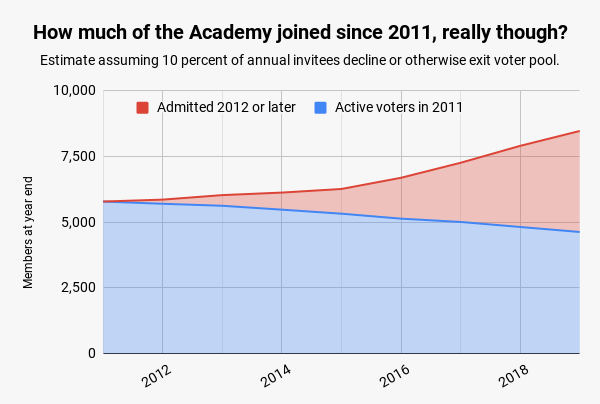Numlock Awards: The Puzzle
Numlock Awards is your one-stop awards season newsletter, and it’s back! Every week, join Walt Hickey and Michael Domanico as they break down the math behind the Oscars and the best narratives going into film’s biggest night. Today’s edition comes from Walter.
What is The Academy?
Let’s start with the basics: The Academy of Motion Picture Arts and Sciences is the group of film industry professionals who award the Oscars.
Take it a step further? The Academy is a black box, a group of voters who delegate the vote counting to some accountants who will never reveal the actual outcome of the election beyond who won it.
A few years ago, that was all there was to it, but then something got harder: the target started moving. The Academy became not just a black box, but a black box that was accumulating and recycling members at an unprecedented rate. They masked their membership, they make their voting algorithm weird and deliberately hard to predict, they added legions of new members over the course of less than a decade, tweaked selection rules, really started to shake things up.
That’s why I see the Academy, at its core, as a puzzle.
A group of the most powerful people in global culture who have gone to extenuating lengths to increase, not diminish, the mystery inherent in their award process. A consortium of film professionals who are one step ahead of their pursuers, deliberately hurling chaff behind them to try to throw the rest of us off the scent. Predicting the Oscars is a difficult because, unlike the NFL or the weather, the people who run the Oscars deliberately don’t want you to succeed, and will go out of their way to make it harder. Oscar forecasters don’t just have a subject, they have an antagonist.
It’s thrilling.

This year is a fascinating one for the Academy. From at least 1999 through 2011, the Academy kept its membership between 5,600 and 5,850 people. Then something changed: in 2012, they invited 176 new members, in 2013, 276 new people, and in 2014, 271. In 2015 they invited 322 people. They were just getting started. In 2016 they invited 683 people, the next year 744 people, the next year 928 people, and this year, 2019, 842 people. (I’m basing these figures on the incredible reporting done annually by Steve Pond at The Wrap.)

This is absolutely nuts. Imagine if, since 2012, the entire population of Ohio moved to Illinois. Imagine trying to predict a Senate election in Illinois. That’s what we’re up against, and it’s thrilling.
The goal for a given year, obviously, is to get as many of the predictions right. But the bigger goal in my view is to better understand this organization, what makes it tick, who is in it, and what we can learn about who gets to define our culture in the process.
In the next few weeks, we’ll revive the prediction forecast models, which in my view as a whole are at their weakest potency in years. Any successful Oscar model has to use data from a limited recent sample size, and based on the data I’ve collected, the amount of data that actually replicates the current composition of the Academy is at an all-time low. This growth phase has to stop eventually — literally, eventually you’re going to run out of people who work in film at this level — and the goal is by then to have a viable model.
Right now, if you were to just look at the maximum replacement model, more people have joined the Academy since 2011 than were voters in 2011.

Again, that’s probably not the case as people decline to join or die or retire or drop out or any number of things. I’d assume probably 10 percent annually don’t join, so in my best estimate, 45 percent of the people in the Academy joined since 2011, which I’ll remark is still quite a bit higher than the 38 percent last year.

But this season, I’m going to tackle another question. Last year, based on the narratives, the film Roma was perceived as a frontrunner in large part because it would have been a preferred choice of a younger, more diverse Academy. That turned out to be false, or at least insufficient. So this year, I want to look at the real shifts in the Academy:

An Academy where the actors branch may be growing, but losing their overall share of the vote. One where a quarter of the growth over the past five years has come from two branches, documentary and short films/feature animation. Where the VFX and at-large branch, including a nascent stunt wing, are on the ascendance.
This year, we try to make a little progress on the puzzle.

